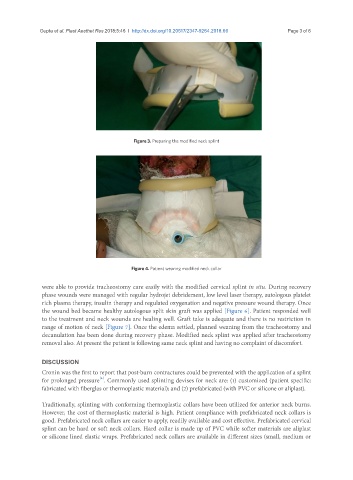Page 346 - Read Online
P. 346
Gupta et al. Plast Aesthet Res 2018;5:46 I http://dx.doi.org/10.20517/2347-9264.2018.66 Page 3 of 6
Figure 3. Preparing the modified neck splint
Figure 4. Patient wearing modified neck collar
were able to provide tracheostomy care easily with the modified cervical splint in situ. During recovery
phase wounds were managed with regular hydrojet debridement, low level laser therapy, autologous platelet
rich plasma therapy, insulin therapy and regulated oxygenation and negative pressure wound therapy. Once
the wound bed became healthy autologous split skin graft was applied [Figure 6]. Patient responded well
to the treatment and neck wounds are healing well. Graft take is adequate and there is no restriction in
range of motion of neck [Figure 7]. Once the edema settled, planned weaning from the tracheostomy and
decanulation has been done during recovery phase. Modified neck splint was applied after tracheostomy
removal also. At present the patient is following same neck splint and having no complaint of discomfort.
DISCUSSION
Cronin was the first to report that post-burn contractures could be prevented with the application of a splint
[4]
for prolonged pressure . Commonly used splinting devises for neck are: (1) customized (patient specific;
fabricated with fiberglas or thermoplastic material); and (2) prefabricated (with PVC or silicone or aliplast).
Traditionally, splinting with conforming thermoplastic collars have been utilized for anterior neck burns.
However, the cost of thermoplastic material is high. Patient compliance with prefabricated neck collars is
good. Prefabricated neck collars are easier to apply, readily available and cost effective. Prefabricated cervical
splint can be hard or soft neck collars. Hard collar is made up of PVC while softer materials are aliplast
or silicone lined elastic wraps. Prefabricated neck collars are available in different sizes (small, medium or

